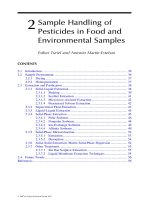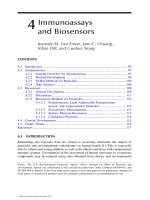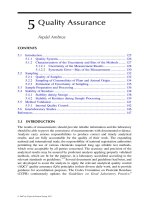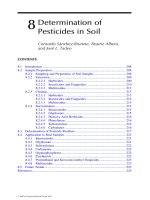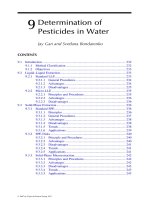- Trang chủ >>
- Y - Dược >>
- Ngoại khoa
oxford case of histories in gastroentrology and hepatology
Bạn đang xem bản rút gọn của tài liệu. Xem và tải ngay bản đầy đủ của tài liệu tại đây (2.53 MB, 368 trang )
Oxford Case Histories
Oxford Case Histories
Series Editors
Sarah Pendlebury and Peter Rothwell
Published:
Neurological Case Histories (Sarah Pendlebury and Peter Rothwell)
Forthcoming:
Oxford Case Histories in Cardiology (Colin Forfar, Javed Ehtisham, and
Rajkumar Rajendram)
Oxford Case Histories in Gastroenterology and Hepatology (Alissa Walsh,
Otto Buchel, Jane Collier, and Simon Travis)
Oxford Case Histories in Nephrology (Chris Pugh, Chris O’Callaghan,
Aron Chakera, Richard Cornall, and David Mole)
Oxford Case Histories in Respiratory Medicine (John Stradling, Andrew
Stanton, Anabell Nickol, Helen Davies, and Najib Rahman)
Oxford Case Histories in Rheumatology (Joel David, Anne Miller, Anushka
Soni, and Lyn Williamson)
Oxford Case Histories in Stroke and TIA (Sarah Pendlebury, Ursula Schulz,
Aneil Malhotra, and Peter Rothwell)
1
Oxford Case
Histories
in Gastroenterology
and Hepatology
Alissa J. Walsh
St.Vincent’s Hospital Staff Specialist
Sydney, Australia
Otto C. Buchel
Consultant Physician and Fellow in Gastroenterology
Universitas Hospital
Bluemfontein, South Africa
Jane Collier
Consultant Hepatologist
Department of Gastroenterology and Hepatology
John Radcliffe Hospital, Oxford, UK
Simon P.L. Travis
Consultant Gastroenterologist
John Radcliffe Hospital
Fellow of Linacre College
University of Oxford
Oxford, UK
1
Great Clarendon Street, Oxford ox2 6dp
Oxford University Press is a department of the University of Oxford.
It furthers the University’s objective of excellence in research, scholarship,
and education by publishing worldwide in
Oxford New York
Athens Auckland Bangkok Bogotá Buenos Aires Cape-Town
Chennai Dar es Salaam Delhi Florence Hong Kong Istanbul Karachi
Kolkata Kuala Lumpur Madrid Melbourne Mexico City Mumbai Nairobi
Paris São Paulo Shanghai Singapore Taipei Tokyo Toronto Warsaw
with associated companies in Berlin Ibadan
Oxford is a registered trade mark of Oxford University Press
in the UK and in certain other countries
Published in the United States
by Oxford University Press Inc., New York
© Oxford University Press, 2010
The moral rights of the author have been asserted
Database right Oxford University Press (maker)
First published 2010
All rights reserved. No part of this publication may be reproduced,
stored in a retrieval system, or transmitted, in any form or by any means,
without the prior permission in writing of Oxford University Press,
or as expressly permitted by law, or under terms agreed with the appropriate
reprographics rights organization. Enquiries concerning reproduction
outside the scope of the above should be sent to the Rights Department,
Oxford University Press, at the address above
You must not circulate this book in any other binding or cover
and you must impose this same condition on any acquirer
British Library Cataloguing in Publication Data
Data available
Library of Congress Cataloguing in Publication Data
Data available
Typeset in Minion by
Glyph International, Bangalore, India
Printed in Great Britain
on acid-free paper by
The MPG Books Group, UK
ISBN 978–0–19–955789–9
10 9 8 7 6 5 4 3 2 1
Oxford University Press makes no representation, express or implied, that the drug dosages in this
book are correct. Readers must therefore always check the product information and clinical procedures
with the most up-to-date published product information and data sheets provided by the manufacturers
and the most recent codes of conduct and safety regulations. The authors and the publishers do not
accept responsibility or legal liability for any errors in the text or for the misuse or misapplication of
material in this work. Except where otherwise stated, drug dosages and recommendations are for the
non-pregnant adult who is not breastfeeding.
A note from the series editors
Case histories have always had an important role in medical education, but
most published material has been directed at undergraduates or residents. The
Oxford Case Histories series aims to provide more complex case-based learn-
ing for clinicians in specialist training and consultants, with a view to aiding
preparation for entry and exit-level specialty examinations or revalidation.
Each case book follows the same format with approximately 50 cases, each
comprising a brief clinical history and investigations, followed by questions on
differential diagnosis and management, and detailed answers with discussion.
All cases are peer-reviewed by Oxford consultants in the relevant specialty. At
the end of each book, cases are listed by mode of presentation, aetiology and
diagnosis.
We are grateful to our colleagues in the various medical specialties for their
enthusiasm and hard work in making the series possible.
Sarah Pendlebury and Peter Rothwell
Quotes on the first book in the series – “Neurological Case Histories”
“I recommend this excellent volume highly this book will enlighten and
entertain consultants, and all readers will learn something.”
Lancet Neurology 2007; 6: 951
“This short and well-written text is designed to enhance the reader’s
diagnostic ability and clinical understanding A well documented and
practical book”
European Journal of Neurology 2007; 14: e19
This page intentionally left blank
Preface
This book contains a series of cases that we have encountered in Oxford
Gastroenterology practice. One purpose is to assist re-validation. Another is to
provide a resource of real cases in preparation for specialist exams. A further
purpose is more general, being educational for physicians in general internal
or emergency medicine, or indeed gastroenterologists, since the cases are often
advanced and sometimes challenging.
All 50 cases include a series of questions, to which we have given detailed,
evidence-based answers, although it is the nature of evidence-based practice
that clinical judgment is also necessary. We have expressed our views, and
hope that you generally agree! We have specifically chosen cases to cover dif-
ferent areas within gastroenterology and hepatology. Included in this selection
are acute cases where rapid diagnosis and treatment are crucial, as well as
chronic disorders that require strategic thinking, and of course, the manage-
ment dilemmas of daily practice.
We have used the format of case reports with detailed discussions of differ-
ential diagnosis and management, for three reasons. First, we believe that one
of the best ways to learn advanced clinical medicine is through the analysis of
individual cases. In almost all areas of medicine, it is extremely difficult to
illustrate the practical process of diagnosis within the format of a traditional
textbook. Second, we strongly believe that it is simply more interesting to con-
sider real cases than to read a text. This allows a clinician to reflect on their own
differential diagnosis and treatment. Finally, there is a lack of case series that
stretch the abilities of experienced clinicians and specialists: most are aimed at
medical students or young doctors doing early postgraduate exams. It is for
this reason that the cases and questions are sometimes challenging, although
many are simple, since the aim is to educate.
We would like to thank the many colleagues from many disciplines, includ-
ing those allied to medicine for contributing cases, providing illustrations, or
administrative support, and always for making helpful comments on the man-
uscript as it developed: these include (in alphabetical order and without titles!)
Adam Bailey, June Beharry, Helen Bungay, Roger Chapman, Rowan Collinson,
Godman Greywoode, Hennie Grundling, Tim James, Christiaan Jansen, Satish
Keshav, Siraj Misbah, Juan Piris, Andrew Slater, Helen Small, Alina Stoita, Jan
van Zyl, Bryan Warren, and David Williams. Cases 16, 26 and 42 were seen and
viii
PREFACE
cared for at the Gastroenterology unit, Universitas Hospital, Bloemfontein,
South Africa, which we gratefully acknowledge. We would also like to thank our
families for their tolerance, patience, and support for work that occupies
evenings, early mornings, and weekends!
Alissa Walsh, Otto Buchel, Jane Collier, Simon Travis
Oxford, August 2009
Contents
Abbreviations xi
Normal ranges xiii
Cases 1–50 1
List of cases by diagnosis 341
List of cases by principal clinical features at diagnosis 343
List of cases by aetiological mechanisms 345
Index 347
This page intentionally left blank
5FU 5-fluorouracil
5HT 5-hydroxytryptamine
AGA American Gastroenterology
Association
AFP α-fetoprotein
ALA aminolaevulinic acid
ALF acute liver failure
ALP alkaline phosphatase
ALT alanine transaminase
AMA antimitochondrial antibodies
ANA antinuclear antigen
ANCA antineutrophil cytoplasmic
antibody
APTT activated partial
thromboplastin time
ARDS acute respiratory distress
syndrome
ASmAb anti-smooth muscle antibody
AST aspartate transaminase
BCG Bacille Calmette-Guérin
bpm beats per minute
BMI body mass index
BSG British Society of
Gastroenterology
C
14
carbon-14
Ca cancer antigen
CBD common bile duct
CDAD Clostridium difficile-associated
diarrhoea
CDT Clostridium difficile toxin
CEA carcinoembryonic antigen
CFTR cystic fibrosis transmembrane
regulator
CMV Cytomegalovirus
CRP C reactive protein
CT computerized tomography
EBV Epstein–Barr virus
ECF epirubicin, cisplatin and
5-fluorouracil combination
chemotherapy
ECG electrocardiogram
ELISA enzyme-linked
immunosorbent assay
EMA endomysial antibody (for
coeliac disease)
ERCP endoscopic retrograde
cholangiopancreatography
ESR erythrocyte sedimentation rate
EOX oxaliplatin and capcytabine
combination chemotherapy
FDA Food and Drug Administration
(USA)
FISH fluorescent in situ
hybridization
FMF familial Mediterranean fever
GABA gamma-aminobutyric acid
GI gastrointestinal
GGT gamma glutamyl
transpeptidase
GIST gastrointestinal stromal
tumour
HAART highly active antiretroviral
therapy
HAV hepatitis A virus
HBcAb antibody to the hepatitis B
core antigen
HBeAg hepatitis B e antigen
HBsAb antibody to the hepatitis B
surface antigen
HBsAg hepatitis B surface antigen
HBV hepatitis B virus
HCV hepatitis C virus
HELLP haemolysis, elevated liver
enzymes, low platelet count
syndrome
Abbreviations
xii
ABBREVIATIONS
HFE High iron FE
(haemochromatomosis gene)
HIV human immunodeficiency
virus
HMB hydroximethylbilane
synthesase
HHV 8 human herpesvirus 8
IBD inflammatory bowel disease
IBS irritable bowel syndrome
IFL irinotecan with 5-fluorouracil
combination chemotherapy
IFN interferon
IL interleukin
INR international normalized ratio
IPMN intraductal
papillary mucinous
neoplasm
IPSID immunoproliferative small
intestinal disease
IVF in vitro fertilization
K potassium
LOLA l-ornithine l-aspartate
LFT liver function test
LKM1 liver kidney microsomal
antibody type 1
LP lumbar puncture
MAC Mycobacterium avium complex
MALT mucosa-associated lymphoid
tissue
MARS molecular absorbent
re-circulating system
MCN mucinous cystic neoplasm
MCV mean cell volume
MDR multi-drug resistant
MELD Model for Endstage Liver
Disease
Mg magnesium
MMR mismatch repair
MRCP magnetic resonance
cholangiopancreatography
MRI magnetic resonance imaging
MRSA methicillin resistant
staphylococcus aureus
MSI microsatellite instability
Na sodium
NAFLD non-alcoholic fatty liver
disease
NASH non-alcoholic steatohepatitis
NAT2 N-acetyltransferase 2
NSAIDs non-steroidal anti-
inflammatory drugs
OLT orthotopic liver
transplantation
pANCA antineutrophil cytoplasmic
antibodies reacting with
myeloperoxidase
PBC primary biliary cirrhosis
PCR polymerase chain reaction
PET positron emission tomography
PICC peripherally inserted central
catheter
PPARγ peroxisome proliferator-
activated receptor gamma
PPI proton pump inhibitor
PSC primary sclerosing cholangitis
PUD peptic ulcer disease
PVC polyvinyl chloride
RUQ right upper quadrant
SCA serous cystadenoma
SIRS systemic inflammatory
response syndrome
SLA soluble liver antigen
SLE systemic lupus erythematosus
SMA spinal muscular atrophy
SSRI Selective serotonin reuptake
inhibitor
TB tuberculosis
TFR2 transferrin receptor 2
TIPSS transjugular intrahepatic portal
systemic shunt
TNF tumour necrosis factor
TSH thyroid stimulating hormone
U&E urea and electrolytes
WCC white cell count
XDR extensively drug resistant
ZES Zollinger–Ellison syndrome
Normal ranges
Normal ranges in the laboratories of the John Radcliffe
Hospital, Oxford
Hb 13–17g1dL (men)
12–15g/dL (women)
MCV 83–101fL (men)
76–96fL (women)
WCC 4–11 x 10
9
/L
Platelets 150–400 x 10
9
/L
Prothrombin time 12–15 secs
INR 0.7–1.1
APTT 24–34 secs
Haptoglobin 0.5–2.65 g/L
Na 135–145 mmol/L
K 3.5–5.0 mmol/L
Urea 2.5–6.7 mmol/L
Creatinine 54–145 umol/L (range
usually corrected for
age or weight)
Calcium 2.12–2.65 mmol/L
Magnesium 0.75 – 1.05 mmol/L
Phosphate 0.80–1.45 mmol/L
CRP 0–8 mg/L
ESR need range
Glucose (fasting) 3.0–5.5 mmol/L
Bilirubin 3–17 µmol/L
AST 15–42 IU/L
ALT 10–45 IU/L
ALP 95–320 IU/L (notably
different between
laboratories,
depending on the
analytical technique)
GGT 15–40 IU/L
Albumin 35–50 g/L
Amylase 25–125 IU/L
AFP 0–7 IU/mL
CEA 0–3 µg/L
Ca
125
0–30 IU/L
Ca
19–9
0–31 U/mL
Ferritin 20–300 µg/L (Men)
10–200 µg/L
(Women)
Folate 4–24 µg/L
Vitamin B
l2
180–900 ng/L
Copper 11–20 µmol/L
Caeruloplasmin 16–60 mg/dL
CD4 lymphocyte
count 0.6–1.5 x10
9
/L
TSH 0.35–5.5 mU/L
Free T
4
10.5–20 pmol/L
Fecal elastase >200 µg elastase/g of
stool
IgA 0.8–3.0 g/L
IgG 6–13 g/L
Ascitic fluid WCC none
This page intentionally left blank
Case 1
A 22-year-old male porter from South Africa was admitted to hospital after
being found by his landlord with confusion. On arrival at the hospital his
Glasgow Coma Score was 13. He was apyrexial, with a blood glucose of
5.4mmol/L, pulse rate 60 beats/min and regular, and blood pressure
114/58mmHg. Heart sounds were normal and his chest was clear. He was
noted to be jaundiced. Asterixis was present. There were no focal neurological
signs. There were no spider naevi, muscle wasting, or gynaecomastia.
His only medical history was pulmonary tuberculosis 6 months earlier, diag-
nosed by pleural biopsy and pleural fluid analysis. He had last been followed
up 2 months previously and was well at that time. He had completed 2 months
of rifampicin, isoniazid, pyrazinamide and ethambutol, followed by rifampicin
and isoniazid alone. There was no record of any other medications or over the
counter preparations. There was no known alcohol or drug history. HIV testing
had been negative.
Investigations showed:
Hb 15.2g/dL, WCC 9.1 x 10
●
9
/L, platelets 173 x 10
9
/L
Na 135mmol/L, K 3.7mmol/L, urea 2.8mmol/L, creatinine 78
●
µmol/L
Bilirubin 357
●
µmol/L, ALT 1307 IU/L, ALP 436 IU/L, albumin 32g/L
Prothrombin time 53.8 sec.
●
Questions
1a) What is the clinical syndrome illustrated by this case?
1b) Give a differential diagnosis for the cause of (a).
1c) What blood tests would you request?
1d) What radiological tests would you request?
1e) What is the management?
1f) What is the most likely cause in this patient and why? What is the
mechanism of injury?
1g) How might this problem have been prevented?
OXFORD CASE HISTORIES
2
Answers
1a) What is the clinical syndrome illustrated by this case?
This is acute liver failure (ALF), which is defined by three criteria:
Rapid development of hepatocellular dysfunction (e.g. jaundice,
●
coagulopathy)
Encephalopathy
●
Absence of a prior history of liver disease.
●
1b) Give a differential diagnosis for the cause of (a)
The differential diagnosis for ALF in this patient includes:
Drugs (paracetamol, antituberculosis medications, propylthioracyl)
●
Hepatotropic viruses (hepatitis B, hepatitis A, hepatitis E, with hepatitis B
●
being the most common)
Acute cryptogenic (non-A, non-B, non-C) hepatitis
●
Autoimmune hepatitis
●
Ischaemia
●
Metabolic disorders such as Wilson’s disease
●
Malignant infiltration.
●
A careful history of past and present medications needs to be taken,
together with a travel history and assessment of risk factors to determine
the likelihood of acute viral hepatitis. Routine viral testing should be done
for all patients (see below). In the presence of tense ascites Budd Chiari
syndrome (hepatic venous outflow obstruction) should be considered,
because ascites is unusual in early acute liver failure from other causes.
Wilson’s disease may present with acute liver failure and should always be
considered in patients presenting at a young age, but usually there is
accompanying haemolysis or renal failure, which were absent in the
present case. Furthermore, the alkaline phosphatase is usually normal in
Wilson’s disease, whereas in this case it was elevated. Fulminant hepatic
failure is an unusual presentation of hepatic neoplasms, whether primary
or metastatic.
Although this patient had ALF, it may be difficult to distinguish this
from acute decompensation of chronic liver disease in patients in whom
the past medical history is unknown. For example, exacerbation of chronic
viral hepatitis (B and C) may produce a similar picture to ALF. Patients
with chronic liver disease, however, usually show stigmata, including
spider naevi, muscle wasting, testicular strophy, or gynaecomastia, none
CASE 1
3
of which were present in this patient. Furthermore, in chronic liver disease
it would be rare for the prothrombin time to be over 40 sec (usually it
would be about 25 sec). In this patient it was 53.8 sec. In alcoholic hepatitis,
the alanine transaminase (ALT) rarely exceeds 300 IU/L, (see box 2)
whereas in this case it was 1370 IU/L.
1c) What blood tests would you request?
A ‘liver screen’ should be performed to look for the cause of ALF
including:
Paracetamol concentration (although N-acetyl cysteine should be
●
started before the result is known, to cover the possibility of toxicity).
Note that paracetamol may be undetectable if the overdose was over
72 hours before blood testing
Hepatitis A IgM
●
Hepatitis B core IgM
●
Autoimmune markers: antinuclear antigen (ANA), anti-smooth muscle
●
antibody (ASmAb), liver kidney microsomal antibody type 1 (LKM1),
and immunoglobulins
Copper and caeruloplasmin to screen for Wilson’s disease.
●
1d) What radiological tests would you request?
An ultrasound of the abdomen should be performed, since this will
help distinguish between acute and chronic liver disease (splenomegaly
is more common in chronic liver disease). This is particularly helpful
in the context of a less severe coagulopathy, where it may be unclear
whether this represents ALF or an acute exacerbation of chronic disease.
Ultrasound will not help to differentiate between different causes
of ALF.
1e) What is the management?
The management of ALF includes:
Intravenous rehydration
●
: most patients require liberal volume expan-
sion, since such patients are often vasodilated, volume depleted and
acidotic. The choice of fluid is not crucial and is usually a mixture of
crystalloid and colloid. Fluid resuscitation can often reverse the
acidosis.
The
●
blood glucose should be measured hourly and replaced: with intra-
venous glucose (10–50%) as necessary, since there is a high risk of
hypoglycaemia. Glucose concentrations need to be maintained to prevent
the cerebral and systemic effects of hypoglycaemia.
OXFORD CASE HISTORIES
4
Arterial blood gas
●
to monitor acidosis: correction of lactic acidosis is
important, because it can affect circulatory function and aggravate
cerebral hyperaemia.
N-acetyl cysteine
●
should be given to cover the possibility of paracetamol
overdose.
Antibiotics
●
: prophylaxis with an intravenous cephalosporin is recom-
mended. Patients with ALF have a high risk of infection and sepsis from
bacterial and/or fungal infection. The use of prophylactic antibiotics is
associated with lower rates of infection complicating ALF. Without
prophylaxis, infection develops in up to 80% of patients with ALF, and
bacteraemia occurs in 20–25% (usually gram-negative organisms).
If definite infection is proven, this should be treated aggressively (e.g.
vancomycin and a third-generation cephalosporin).
Vitamin K is not indicated: bleeding is unusual in ALF despite the
●
increased prothrombin time. Fresh frozen plasma is not advocated,
because the risks (fluid overload, normalization of the prothrombin
time artificially) outweigh the benefits. Plasma product should be used
only if the patient is bleeding or an invasive procedure is being
performed. The prothrombin time is also a good prognostic indicator.
Lactulose is of no proven benefit in ALF.
●
Intensive care management
●
: if the patient is not protecting their airway
(grade 3 or 4 encephalopathy), intubation and ventilation is indicated.
This applies especially during transfer to a transplant unit, because
grade 4 encephalopathy can develop rapidly.
Liver transplant
●
: In patients with acute liver failure, liver transplanta-
tion should be considered at an early stage and the regional liver
transplant unit contacted for advice. In paracetamol-induced ALF,
referral to a transplant unit should be made if the prothrombin time is
>60 sec. For non-paracetamol acute liver failure, the criteria are listed
below.
The King’s College Hospital criteria for liver transplantation in non-
paracetamol ALF are:
INR >6.5 or prothrombin time >100 sec
●
OR three of the following:
patient age <11 years old or >40 years old
●
serum bilirubin >300
●
µmol/L
time from onset of jaundice to development of coma >7 days
●
CASE 1
5
INR >3.5 or prothrombin time >50 sec
●
aetiology: non-A, non-B, or drug toxicity (not paracetamol).
●
It should be noted that patients should be transferred well before the
development of these criteria. The patient in this case met the criteria on
admission, since he had a prothrombin time of 53.8 sec, bilirubin of
357µmol/L, and drug toxicity as the aetiology (below).
1f) What is the most likely cause of ALF in this patient and why? What is the
mechanism of injury?
The most likely cause of ALF in this patient is isoniazid toxicity. One to
two percent of patients receiving isoniazid develop severe liver injury,
defined as an ALT being at least 3 times the upper limit of normal.
Fulminant hepatotoxicity is well described and has 10–20% mortality if the
isoniazid is continued. The mechanism of injury is the production of toxic
metabolites through isoniazid oxidation in the cytochrome p450 pathway.
These metabolites accumulate in people who are slow acetylators and in
those on concurrent enzyme-inducing medication such as rifampicin or
alcohol. Although it remains controversial, certain polymorphisms of
N-acetyltransferase 2 (NAT2) and glutathione-S-transferase genes are also
thought to be risk factors. Other risk factors for hepatotoxicity include
underlying liver disease (especially coexistent hepatitis B or hepatitis C),
other hepatotoxic medications (such as protease inhibitors for treatment of
HIV), excessive alcohol consumption, age >35 years, and female gender. It
is unclear whether race or malnutrition contributes to the risk of toxicity.
1g) How might this problem have been prevented?
Before starting antituberculous treatment the patient requires education
regarding the medication. Detection of risk factors for toxicity (1f, above)
is important and every patient should have baseline LFTs. Individual
patients need to be aware that they should see a doctor if non-specific
symptoms occur. If the ALT is >5 times normal, or if symptoms arise,
then antituberculous medications need to be stopped. If the ALT is 2–4
times normal, then liver function tests should be checked weekly for 2
weeks and then fortnightly until they have improved. If treatment needs
to be continued, alternative agents such as ethambutol or fluoroquinolo-
nes should be considered, since these are the least hepatotoxic. Once the
LFTs have normalized, antituberculous drugs should be reintroduced
one by one. Rifampicin is usually introduced first and then isoniazid.
Pyrazinamide should be omitted if possible. These drugs are often tolerated
on reintroduction.
OXFORD CASE HISTORIES
6
Further reading
Devlin J, O‘Grady J (1999). Indications for referral and assessment in adult liver transplantation:
a clinical guideline. Gut; 45(Suppl. 6): V11–V121.
Jalan R (2005). Acute liver failure: current management and future prospects. J Hepatol; 42:
S115–S123.
Sass DA, Obaid Shakil A (2005). Fulminant hepatic failure. Liv Trans; 11: 594–605.
CASE 2
7
Case 2
A 24-year-old female hairdresser presented with a 5-day history of jaundice,
right upper quadrant discomfort, and general malaise. Her stool was of normal
colour and not pale, nor did she have dark urine. She admitted to recent
alcohol excess while on holiday in Ibiza, from where she had returned 10 days
before. Her usual alcohol intake was 24 units/week, with binges during
social events. She had no past medical history and used no prescription drugs,
over-the-counter medications or NSAIDs, no nutritional supplements
or herbal remedies, and no illicit drugs. She had not recently had a course of
antibiotics. There was no history of previous blood transfusion, contact with
hepatitis, or previous jaundice, and she had no tattoos. She had last had unpro-
tected sex 8 months previously. There was no significant family history.
On examination she was clinically well, haemodynamically stable, and apy-
rexial. She was jaundiced, without lymphadenopathy, peripheral oedema, or
finger clubbing. There were no signs of chronic liver disease or portal hyper-
tension. She had a liver edge, palpable 3 cm below the costal margin, which
was firm, smooth and non-tender. Cardiac and respiratory examination was
unremarkable.
Investigations showed:
Hb 13.4g/dL, WCC 4.22 x 10
●
9
/L, platelets 182 x 10
9
/L
Prothrombin time 13.2 sec, APTT 36.1 sec
●
Bilirubin 56
●
µmol/L, ALT 2858 IU/L, ALP 626 IU/L, albumin 40g/L
Ultrasound scan of the abdomen: mild splenomegaly with a span of
●
13.5cm. No gallstones, but there was slight thickening of the gallbladder
wall. The liver was homogeneous and of normal size. The pancreas, bile
duct, kidneys, and spleen appeared sonographically normal.
OXFORD CASE HISTORIES
8
Questions
2a) What is the clinical problem and the differential diagnosis in this case?
2b) What is the significance of the ultrasound findings?
Further investigation revealed: hepatitis A IgM negative, hepatitis B surface
Ag negative, cytomegalovirus IgM negative, EBV IgG positive, ANA positive
1/640, smooth muscle antibody negative, antimitochondrial antibody
negative, IgG 35.6g/L, IgM 1.76g/L, IgA 2.81g/L.
2c) What is the most likely diagnosis given these investigation results?
2d) What would be your next investigation?
2e) How would you treat this patient?
This page intentionally left blank
OXFORD CASE HISTORIES
10
Answers
2a) What is the clinical problem and the differential diagnosis in this case?
The clinical features of this case are consistent with acute hepatitis.
Acute hepatitis is characterized by mild jaundice, lethargy, and markedly
elevated transaminases. The sudden onset of symptoms in the presence of
a normal albumin suggests acute liver injury. There is no evidence of acute
liver failure, because the prothrombin time is normal (see Case 1, acute
liver failure).
The differential diagnosis in this case includes:
Viral hepatitis
●
Toxins
●
Autoimmune disease.
●
Viral, toxic (drug), and autoimmune causes may be responsible for mark-
edly elevated transaminases. Recent travel to a coastal resort raises the
possibility of shellfish consumption, which increases the risk of hepatitis A
virus infection. The return from Ibiza 10 days prior to presentation is
compatible with the incubation period for hepatitis A virus infection (see
Case 16). There is no history of high-risk sexual behaviour within the past
90 days, and no contact with blood or blood products, so acute hepatitis B
virus infection is unlikely. Hepatitis A (see Case 16), hepatitis B (see Case
44), cytomegalovirus and Epstein–Barr virus infections should, never-
theless, be excluded by appropriate serology. If other investigations are
negative, Hepatitis E virus infection should be considered. Acute presen-
tation of hepatitis C virus infection (see Case 43) is rare, but should be
considered once other aetiologies have been excluded, especially if risk
factors such as intravenous drug abuse are present. Drug-induced hepati-
tis in our patient is effectively excluded by the history, but checking a
paracetamol concentration on admission would be a sensible precaution.
Even though she has a history of binge drinking, the markedly elevated
ALT is against an acute alcoholic hepatitis, in which transaminases rarely
exceed 300 IU/L (see Case 1). In our patient, hepatomegaly was not
marked and the leucocyte count was normal, which makes alcoholic hepa-
titis less likely, since it is associated with peripheral leucocytosis. Excess
alcohol consumption may lead to fatty liver with hepatomegaly (see Case
45). Autoimmune hepatitis should be excluded, and investigation should
include autoantibodies and immunoglobulin fractions.





